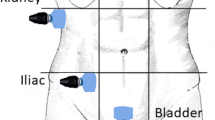Abstract
The present investigation aimed to point out some epidemiological and clinical features of renal colic in our region. All emergency department (ED) visits performed from 1 January to 31 December 2005 were reviewed to select those with diagnosis of renal colic or kidney stones. There were 70,621 visits to the University of Pisa ED. Renal colic or stone were diagnosed in 696 cases (1%); 21.6% of them were recurrent stone formers; the males to female ratio was 1.4–1. The age distribution showed a higher rate from 25 to 44 years of age, whereas seasonal distribution showed a higher risk during summer months, particularly in July. Ultrasonography (US) was the only examination in 70.2% cases, it was coupled with plain abdomen X-ray (KUB) in 10% of the cases. NSAIDs were always used (100%), sometimes in association with opiate (15.8%) or with anti-cholinergic (26.5%) medications. The data of our investigation are in a substantial agreement with the reported literature as far as concerns the main epidemiological features of renal colic and its treatment. On the contrary, the diagnostic approach is mainly based on US whereas KUB is rarely performed. Until the 31st of December 2005, CT-scan was not used as the first and only imaging study in cases of renal colic. This different diagnostic approach may be linked to financial and cultural reasons, and structural and functional organization of the National Health Service facilities.
Similar content being viewed by others
References
Coe FL, Parks JH, Asplin JR (1992) The pathogenesis and treatment of kidney stones. N Engl J Med 327:1141–1152
Ramello A, Vitale C, Marangella M (2000) Epidemiology of nephrolithiasis. J Nephrol 13:S45–S50
Amato M, Lusini ML, Nelli F (2004) Epidemiology of nephrolithiasis today. Urol Int 1:1–5
Wilkinson H (2001) Clinical investigation and management of patients with renal stones. Ann Clin Biochem 38:180–187
Press SM, Smith AD (1995) Incidence of negative hematuria in patients with acute urinary lithiasis presenting to the emergency room with flank pain. Urology 45:753–757
Borghi L, Caudarella R, Gambero G, Marangella M, Messa PG. Linee Guida per la Nefrolitiasi. http://www.sin-italy.org
Dalrymple NC, Verga M, Anderson KR, Bove P, Covey AM, Rosenfield AT, Smith RC (1998) The value of unenhanced helical computerized tomography in the management of acute flank pain. J Urol 159:735–740
Weldon L, Esler SJ, Bryan J, et al (2000) Low-dose nonenhanced helical CT of renal colic: assessment of ureteric stone detection and measurement of effective dose equivalent. Radiology 215:51–54
Lieske JC, Pena de la Vega LS, Slezak JM et al (2006) Renal stone epidemiology in Rochester, Minnesota: an update. Kidney Int 69:760–764
Meliani E, Lombardi M, Vannini R, et al (2005) Impatto delle coliche renali sul DEA di una grande azienda sanitaria: l’esperienza nell’area fiorentina. Giornale di Tecniche Nefrologiche & Dialitiche 4:16–18
Brown J (2006) Diagnostic and treatment patterns for renal colic in US Emergency Departments. Int Urol Nephrol 38:87–92
Chauhan V, Eskin B, Allegra JR, Cochrane DG (2004) Effect of season, age, and gender on renal colic incidence. Am J Emerg Med 22:560–563
Basiri A, Moghaddam SM, Khoddam R, Nejad ST, Hakimi A (2004) Monthly variations of urinary stone colic in Iran and its relationship to the fasting month of Ramadan. J Pak Med Assoc 54:6–8
al-Hadramy MS (1997) Seasonal variation of urinary stone colic in Arabia. J Pak Med Assoc 47:281–284
Manfredini R, Gallerani M, Boari B, Fersini C, Portaluppi F (2002) Circadian pattern in occurrence of renal colic in an emergency department: analysis of patients’ notes. BMJ 324:767
Drudi FM, Profiti R, Marchetti F (2004) Diagnostica per immagini nella nefrolitiasi. Giornale di Tecniche Nefrologiche & Dialitiche 3:26–28
Lindqvist K, Hellstrom M, Holmberg G, Peeker R, Grenabo L (2006) Immediate versus deferred radiological investigation after acute renal colic: a prospective randomized study. Scand J Urol Nephrol 40:119–124
Otal P, Irsutti M, Chabbert V, et al (2001) Radiologic study of renal colic. J Radiol 82:27–33
Dalla Palma L, Stacul F, Mosconi E, Pozzi-Mucelli R (2001) Ultrasonography plus direct radiography of the abdomen in the diagnosis of renal colic: still a valid approach? Radiol Med 102:222–225
Das D, Teece S (2006) Best evidence topic report. Intravenous NSAID’s in the management of renal colic. Emerg Med J 23:225
Holdgate A, Pollock T (2004) Systematic review of the relative efficacy of non-steroidal anti-inflammatory drugs and oppioids in the treatment of acute renal colic. BMJ 328(7453):1401. Epub 2004 Jun 3. Review. Erratum in: BMJ. 2004 Oct 30;329(7473):1019
Holdgate A, Oh CM (2005) Is there a role for antimuscarinics in renal colic? A randomized controlled trial. J Urol 174:572–575
Singh A, Alter HJ, Littlepage A (2007) A systematic review of medical therapy to facilitate passage of ureteral calculi. Ann Emerg Med 50:552–563
Author information
Authors and Affiliations
Corresponding author
Rights and permissions
About this article
Cite this article
Cupisti, A., Pasquali, E., Lusso, S. et al. Renal colic in Pisa emergency department: epidemiology, diagnostics and treatment patterns. Intern Emerg Med 3, 241–244 (2008). https://doi.org/10.1007/s11739-008-0145-z
Received:
Accepted:
Published:
Issue Date:
DOI: https://doi.org/10.1007/s11739-008-0145-z




